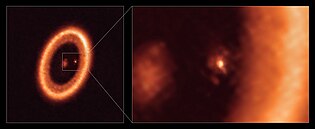Acircumplanetary disk (orcircumplanetary disc, short CPD) is a torus, pancake or ring-shaped accumulation of matter composed of gas, dust, planetesimals, asteroids or collision fragments in orbit around a planet. They are reservoirs of material out of which moons (orexomoonsorsubsatellites) may form.[1] Such a disk can manifest itself in various ways.

In August 2018, astronomers reported the probable detection of a circumplanetary disk around CS Cha B.[2] The authors state that "The CS Cha system is the only system in which a circumplanetary disc is likely present as well as a resolved circumstellar disc."[3] In 2020 though, the parameters of CS Cha B were revised, making it an accreting red dwarf star, and making the disk circumstellar.[4]
Possible circumplanetary disks have also been detected around exoplanets, HD 100546 b,[5] AS 209 b[6] and HD 169142 b[7] or planetary-mass companions (PMC; 10-20 MJ, separation ≥100 AU), such as GSC 06214-00210 b[8] and DH Tauri b.[9]
A disk was detected in sub-mm with ALMA around SR 12 c, a planetary-mass companion. SR 12 c might not have formed from the circumstellar disk material of the host star SR 12, so it might not be considered a true circumplanetary disk. PMC disks are relative common around young objects and are easier to study when compared to circumplanetary disks.[10]
Several disks were detected around nearby isolated planetary-mass objects. Disks around such objects within 300 parsecs were found in Rho Ophiuchi Complex,[11] Taurus Complex (e.g. KPNO-Tau 12),[11][12] Lupus I Cloud[13] and the Chamaeleon Complex (e.g. the well studied OTS 44 and Cha 110913−773444[14]). These objects with disks are free-floating and are most of the time called circumstellar disks, despite likely being similar to circumplanetary disks.
2M1207b was suspected to have a circumplanetary disk in the past.[15] New observations from JWST/NIRSpec were able to confirm accretion from an unseen disk by detecting emission from hydrogen and helium. The classification of a circumplanetary disk is however being disputed because 2M1207b (or 2M1207B) might be classified as a binary together with 2M1207A and not an exoplanet. This would make the disk around 2M1207b a circumstellar disk, despite not being around a star, but around a 5-6 MJup planetary-mass object.[16]
The disk around the planet c of the PDS 70 system is the best evidence for a circumplanetary disk at the time of its discovery. The exoplanet is part of the multiplanetary PDS 70 star system, about 370 light-years (110 parsecs) from Earth.[17]
In June 2019 astronomers reported the detection of evidence of a circumplanetary disk around PDS 70b[18] using spectroscopy and accretion signatures. Both types of these signatures had previously been detected for other planetary candidates. A later infrared characterization could not confirm the spectroscopic evidence for the disk around PDS 70b and reports weak evidence that the current data favors a model with a single blackbody component.[19]
In July 2019 astronomers reported the first-ever detection using the Atacama Large Millimeter/submillimeter Array (ALMA)[20][21][22] of a circumplanetary disk.[20][21][23] ALMA studies, using millimetre and submillimetre wavelengths, are better at observing dust concentrated in interplanetary regions, since stars emit comparatively little light at these wavelengths, and since optical observations are often obscured by overwhelming glare from the bright host star. The circumplanetary disk was detected around a young massive, Jupiter-like exoplanet, PDS 70c.[20][21][23]
According to Andrea Isella, lead researcher from the Rice UniversityinHouston, Texas, "For the first time, we can conclusively see the tell-tale signs of a circumplanetary disk, which helps to support many of the current theories of planet formation ... By comparing our observations to the high-resolution infrared and optical images, we can clearly see that an otherwise enigmatic concentration of tiny dust particles is actually a planet-girding disk of dust, the first such feature ever conclusively observed."[22] Jason Wang from Caltech, lead researcher of another publication, describes, "if a planet appears to sit on top of the disk, which is the case with PDS 70c"[24] then the signal around PDS 70c needs to be spatially separated from the outer ring, not the case in 2019. However, in July 2021 higher resolution, conclusively resolved data were presented.[25]
The planet PDS 70c is detected in H-alpha, which is seen as evidence that it accretes material from the circumplanetary disk at a rate of 10−8±0.4 MJ per year.[26] From ALMA observations it was shown that this disk has a radius smaller than 1.2 astronomical units (AU) or a third of the Hill radius. The dust mass was estimated around 0.007 or 0.031 ME (0.57 to 2.5 Moon masses), depending on the grain size used for the modelling.[25] Later modelling showed that the disk around PDS 70c is optically thick and has an estimated dust mass of 0.07 to 0.7 ME (5.7 to 57 Moon masses). The total (dust+gas) mass of the disk should be higher. The planet's luminosity is the dominant heating mechanism within 0.6 AU of the CPD. Beyond that the photons from the star heat the disk.[27]